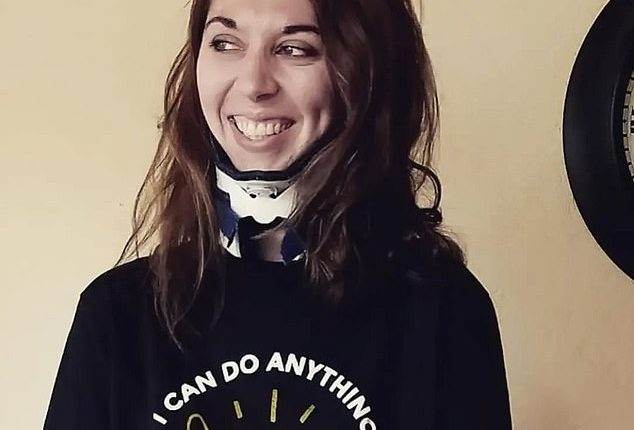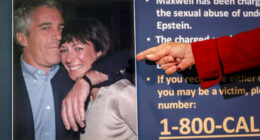An Illinois woman has revealed how a horrific sports accident left her on the verge of being ‘internally decapitated’ and made her life miserable.
Megan King was just 16 in 2005 when she leapt in the air to catch a soccer ball during gym class and fell to the ground, damaging her right ankle and spine and tearing the muscle off both shoulder blades.
The teenager spent more than a year on crutches. Instead of her symptoms subsiding, more appeared. King’s joints weakened and her muscles began to tear, and her shoulder blades ached in unbearable pain.
Over the years, she underwent 22 surgeries on her shoulders and shoulder blades alone, with doctors mystified as to why her body couldn’t heal.
It took 10 years for King to be diagnosed in 2015 with hypermobile Ehler’s-Danlos syndrome (hEDS), a genetic disorder that stops collagen — a key joint tissue — from forming properly and leads to joint instability.
A year later, King’s neck became dislocated and she was fitted with a Halo brace, a brutal contraption that screws directly into the skull to keep the neck from moving.
During the process to remove the device, her skull nearly became detached from her spine, an almost always deadly condition called internal decapitation or Atlanto-occipital dislocation (AOD).
King, now 35, said: ‘I flew my chair back to keep gravity from decapitating me. My neurosurgeon had to hold my skull in place with his hands. I couldn’t stand. My right side was shaking uncontrollably.’

Megan King was just 16 in 2005 when she fell in gym class. Her injuries worsened over the next two decades, which doctors later learned was due to hypermobile Ehler’s-Danlos syndrome

About 10 years after her initial injury, King’s skull nearly became detached from her spine, an almost always deadly condition called internal decapitation or Atlanto-occipital dislocation (AOD
King was rushed into emergency surgery, where doctors spent fused her skull back on to her spine.
‘It was a horror show. I woke up unable to move my head at all,’ she said.
She has now had 37 surgeries and is fused from her skull down to her pelvis, meaning she can no longer shift her head up, down, left or right.
A spinal fusion involves wo or more vertebrae – bones in the spine – are joined together to keep them from moving.
King said: ‘I’m literally a human statue. My spine doesn’t move at all. But that doesn’t mean I’ve stopped living.’
AOD occurs when the occipital bone at the base of the skull detaches from the atlas, the first or C1, the topmost vertebrae in the spine.
The injury is fatal in over 90 percent of cases, as the damage disrupts nerve signals between the brain and the body, leading to paralysis around vital organs like the lungs and heart, impairing their function.
Stabilizing the head is crucial to keep it from separating further from the spine.
AOD is more commonly seen in children and adolescents because the bones are not fully developed yet and may still contain cartilage. They’re also more likely to have proportionally larger heads and weaker neck muscles than adults.

King, now 35, said: ‘I flew my chair back to keep gravity from decapitating me. My neuosurgeon had to hold my skull in place with his hands. I couldn’t stand. My right side was shaking uncontrollably’

The above iamge shows the fusions in King’s neck and spine. She is now fused from her skull to her pelvis

King is slowly regaining her ability to get back to hobbies she had before that fateful fall 20 years ago, including walking with her dogs and bowling
About eight in 10 AOD cases are due to severe trauma like car crashes, though King’s case was likely due to the combination of her fall in high school and her hEDS, the joint weakening condition she also suffers from.
AOD itself is rare, accounting for just one percent of all cervical spine injuries.
Now, King is fused from her skull to her pelvis and can’t bend, twist or slouch.
However, she is slowly regaining her ability to get back to hobbies she had before that fateful fall 20 years ago. This includes a recent bowling outing.
She said: ‘I didn’t plan on playing. I was just there to watch friends. But something in me said, “Why not try?”‘
‘I bowled a strike—on my very first try. My friends screamed and clapped and cheered like wild. They weren’t just celebrating the strike. They were celebrating everything I’ve survived.’
That one strike turned into three that night.
King said: ‘I’m still learning what my new body can do.It’s not easy, but I’m adapting. And I’m always surprised by what I can still accomplish.”





